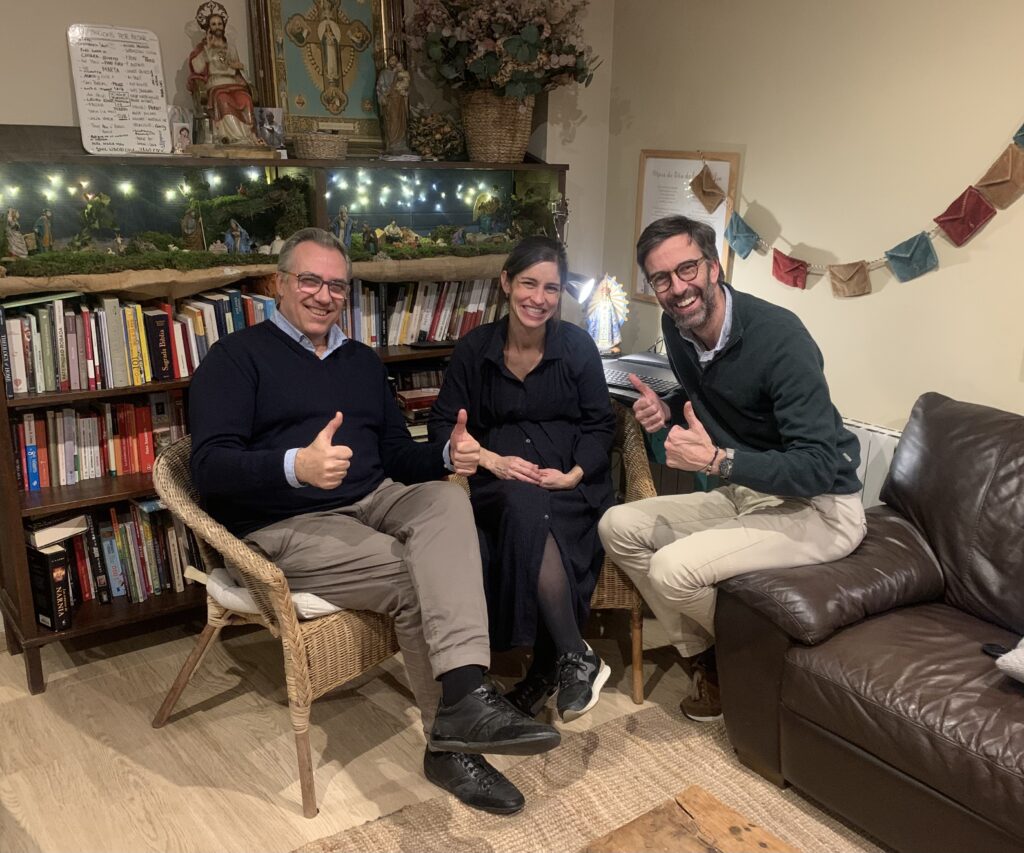Challenge to Accept Oneself and to Live Virtues
Interview with Father Alejandro Ortega Trillo

How can we live virtues? How can we overcome pride with humility and sloth with work? How can we succeed in imposing generosity over avarice and simplicity over vanity?
Life is a constant challenge, which defies us to overcome temptations and make an effort to achieve the best version of ourselves. It confronts us with all sorts of obstacles, which makes us grow. However, the greatest challenge is within us, in the struggle that every human being fights between his vices and virtues. In order to overcome ourselves, we must look to our interior, really know ourselves and decide to change willingly.
Father Alejandro Ortega Trillo talked with Exaudi about “The challenge to accept oneself and to live the virtues.”
Father Ortega is a writer, radio and television commentator, and international speaker. He is the author of the books “Vices and Virtues” (a best seller with over 100,000 copies sold); “War in the Bedchamber,” and “The Seven Big Topics of Engagement and Marriage,” as well as of editorial articles published in different media and social networks. At present, he carries out his ministry in the Archdiocese of San Antonio, Texas.
There are those that think that to be concerned with vices (defects, sins) is negative. Why talk about this?
Before entering the Seminary, I studied Medicine and one of the first things that one learns is that to cure an illness the first thing to do is a good diagnosis. Therefore, when I wrote the book “Vices and Virtues,” I decided to dedicate the first part to personal knowledge, to discover my own battlefield, not only is it the place where our emotional or moral wellbeing lies but also our sanctification. We all have a battlefield. In the Book of Job, Sacred Scripture describes life as a battle and we experience this every day.
What are the vices and which are the most common in a human being?
Vices are evil moral habits, namely, behavior rooted in our personality that diminishes our personal moral stature. In the book “Vices and Virtues” I present ten vices. It’s not an exhaustive list; it doesn’t even correspond to the so-called “capital sins,” which has its origin in the teaching of a 4th-century desert monk called Evagrius Ponticus, who was the first to make a list of vices or “evil spirits.” Later, the Church consolidated the list more formally in seven “capital sins,” which are the ones that we know at present in the Catholic Tradition.
The focus of my book is rather of a phenomenological nature, that is, my list of vices stems from my experience as Spiritual Director and Confessor. Five vices are of a more corporal character, and they are brought together under the concept of “sensuality.” The other five are of a more spiritual nature, and we include them as a whole under the concept of “pride.” This distinction of two groups of vices is based on the recognition that our human nature, in keeping with basic anthropology, has two inseparable elements: soul and body. The vices of the body are sloth, intemperance, lust, comfort, and avarice. On the spiritual side, we have pride, vanity, self-sufficiency, susceptibility, and rebellion.
When our defects make us suffer, how can we see their good side?
The work I propose in the book is to accept and recognize in each vice an area of opportunity. We all have a bit of all the vices, but there is one that predominates in every person. It’s what we call the “dominant vice.” The key of spiritual work is to detect one’s dominant vice, not to become frustrated, to despair, and to be sad, but to recognize one’s area of work and opportunity. Looking at it from a more spiritual, more supernatural point of view, we can say that one’s dominant vice is the cross that God has permitted in one’s life. We all carry a very personal and non-transferable cross and that cross goes hand in hand with one’s dominant vice. There is no doubt that our evil inclinations and tendencies hurt our relationship with God, with others, with ourselves, and even with the creatures around us. However, one can accept them as one’s cross and make one’s best effort to bear them as opportunities for interior growth. Jesus says so in the Gospel: “If any man would come after me, let him deny himself and take up his cross and follow me” (Matthew 16:24-28).
What are the virtues? What’s the use of forging virtues?
Virtues are exactly the opposite of vices: they are good moral habits. A habit isn’t an isolated act; it’s not something done once. A habit is conduct rooted in one’s personality and based on the repetition of acts. There are many other kinds of habits (physical, intellectual, emotional, etc., which do not necessarily have a moral connotation.). Vices, instead, are evil moral habits, because they affect our human stature. The moral dimension has to do with our condition as human persons. An act that is morally good makes one grow in one’s human stature; an evil moral act (immoral) diminishes one’s stature as a human person because our essence as human beings is not fixed, but for allows growth or decrease, as opposed to the essence of things, which are what they are and can’t be “more” or “less” than what they are. A human being can grow in his humanity and this is morality: that which makes one grow or decrease in one’s status as a human person. A virtue is a good moral habit that, every time it is exercised, enhances one’s human stature.
How can we find and empower the best version of ourselves?
To know our vices and work on the virtues empowers definitively the best version of ourselves. It’s not about achieving a version of appearance, but about profound interior growth from our essence as human beings. Obviously, when we grow as human beings our capacity to relate to others, to God, to things and circumstances is also enhanced and improved, as well as our relationship with ourselves, in that interior dialogue where consciously or unconsciously we are constantly assessing and qualifying ourselves. To work on virtue is to confront one’s reality and improve it through the conquest of the virtue that each one most needs.
This virtuous lifestyle implies much mortification, an option that is discarded given the offers of happiness that today’s world and society suggest to us. How can this obstacle be overcome?
The penultimate chapter of the book on “Vices and Virtues” addresses the subject of the elaboration of a program of life, which implies deciding on what virtue we are going to work and how we will do so in practice. I usually stress that the program of life does not consist so much in removing defects as in building virtues. Therefore, the program’s points to work on must be very positive. Here is an example: let us imagine that a person’s dominant defect is sloth, whose most obvious manifestations could be: to get up late, finding it difficult to follow an agenda of activities, and lacking punctuality. In a good program of life, these three manifestations should be drawn up in a positive and motivating way, that is: “I’ll get up early,” I’ll write an agenda indicating the activities of the day,” “I’ll be implacably punctual.” Yes, it’s true, that to work like this means mortification, discipline, and the structuring of one’s life. However, how well we feel when we carry out our good resolutions!
Moreover, it should be pointed out that, as human beings, we are designed for such continuous growth. Austrian psychiatrist Victor Frank said that health “is based on a certain tension.” Our life requires this certain tension, otherwise, we get sick, be it in the physical and mental realm or in the moral and spiritual. To have a healthy “tension” in life (a project or a challenge) gives us physical and spiritual health. In other words, it’s not so bad to have to struggle; it’s the price of spiritual maturity whose fruit is a type of peace compatible with that struggle between vices and virtues, which is unleashed in our hearts every day.
How can one make the work of human improvement: “Know yourself, accept yourself and improve yourself” not become a merely human effort, but integrate it with the help that comes from God?
I wrote the book thinking of all human beings, whether believers or not. So, the content is not a treatise on Moral Theology. However, I don’t fail to point out that we all need God’s help or that of a Transcendent Being who is the origin and destiny of our life. Undoubtedly, divine grace is an extraordinary aid to grow in virtue, not forgetting the gifts of the Holy Spirit that Catholic Tradition acknowledges.
Today there is little talk on this subject. How can we teach our children the Christian virtues?
It’s true; in the education of children, moral virtues are usually a subject that is often neglected. Given the tendency of the present educational system, many fathers and mothers of families are more interested in the development of their children’s abilities than in their acquiring moral knowledge and virtues. It’s important to recognize today, in the new generations of children and young people ending a school stage, a great lack of knowledge together with a high development of abilities. However, knowledge and abilities are still very superficial when speaking of virtues. I usually explain it with the image of a tree, where the foliage equals knowledge and the branches’ abilities, but this alone doesn’t define a tree. Then comes the trunk, which corresponds to emotional strength and to what is usually called “personal security.” But this is still not what is most important for the tree. What is most important is what is not seen: the roots and sap that give life to the tree. The roots correspond to the person’s principles, values, and the sap to his motivations. Saint Augustine already said it: “The root is profoundly entrenched in the earth; where our root is, there is our life, there is our love” (CS 36, s. 1,3). If a child is educated from the root, then all the rest will follow.
Note: Father Alejandro Ortega Trillo’s book “Vices and Virtues,” with over 100,000 copies sold, can be acquired through Amazon; in the United States it has been published by Liguori Publications in Spanish and English; in Mexico and Latin America by Grupo Planeta, and in Italy by Edizioni San Paolo.
Translation by Virginia M. Forrester
Related
 (EN)
(EN)
 (ES)
(ES)
 (IT)
(IT)





